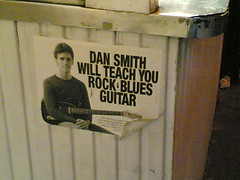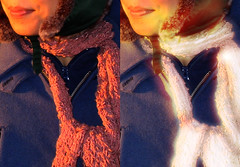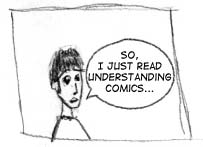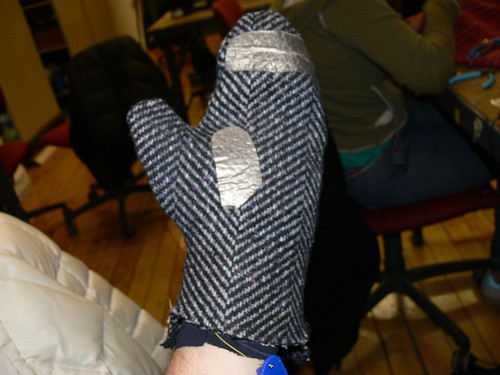In the form of a comic…
Category Archives: ITP
PixTrak, aka the Dan Smith Will Teach You Rock & Blues Guitar Tracker
 My mobile app will be a MMS game dedicated to New York City bulletin-board guitar legend, Dan Smith.For the uninitiated, Dan Smith has been teaching guitar in New York City for a long long time. I was struck by how often I see his flyers posted around the city – and I wondered, how much does this guy get around? Is it just the East Village, where I usually see these posters, or even the Upper East Side, where I’ve seen a couple as well. I think lots of New Yorkers must know this Dan Smith guy, even if they’ve never taken a lesson from him. There’s a hidden sense of community lurking behind the bold print and black and white photography: this guy lives in MY city.
My mobile app will be a MMS game dedicated to New York City bulletin-board guitar legend, Dan Smith.For the uninitiated, Dan Smith has been teaching guitar in New York City for a long long time. I was struck by how often I see his flyers posted around the city – and I wondered, how much does this guy get around? Is it just the East Village, where I usually see these posters, or even the Upper East Side, where I’ve seen a couple as well. I think lots of New Yorkers must know this Dan Smith guy, even if they’ve never taken a lesson from him. There’s a hidden sense of community lurking behind the bold print and black and white photography: this guy lives in MY city.
response to Shaw on Ibsen
on G.B. Shaw’s essay “The Technical Novelty in Ibsen’s Plays” (with a little Brecht thrown in for good measure):
I don’t think that Shaw’s notion of plays as ‘discussion’ is necessarily incompatible with the Action-based theories of Aristotle. Indeed, Shaw is not arguing for just plays with people talking about ideas, which Robert McKee or David Ball would find untenable. Discussion as a play’s motivation, I think in Shaw’s eyes, is more about the nature of ideas themselves, which are deeply rooted in individual’s desires, and therefore their actions.
When A Doll’s House shifts to the discussion mode, the characters are laying their inner subtext bare, so that actions=ideas; Nora’s decision to leave Torvald is not then, because of the untenable circumstances of the plot, but driven by the conflict of her desires with torvald (and society).
Most importantly, when the audience can feel the shift when the play goes south of their well-made-play expectations. The playwright then has the opportunity to really engage them on an intellectual level. As opposed to simply the emotional joyride of tension and release that the well-made play offers, this jarring shift forces the audience to look at the play, and the characters situations, from a more mindful, thoughtful place.
This was Brecht’s goal too, his alienation effect was not meant to turn the audience off, but to force them to find distance from the play so they can think about it on a deeper level than plot and circumstance. That said, I have seen Brecht-inspired (or so they claimed) works that pushed the audience too far away, so that the only intellectual engagement was on technical or directorial feats.
Personally I think there’s a middle ground between intellectual and emotional goals in the theater, and narrative in general. I think that by generating a powerful emotional response in an audience, you can stimulate their minds not just during the narrative experience, but for some time after.
Meta-narrative examples
For post-linear narrative lab we were asked to bring some examples of meta-narrative. Some of my favorites:
Anything Andy Kaufman did. Most obviously, the foreign-guy-into-Elvis routine. There is self-conscious shift which causes the audience to re-evaluate what they’ve just seen. This actually works on two meta levels; first the foreign guy’s flailing attempts at ‘comedy’ are themselves a commentary on the tradition of stand-up; then after the dead on elvis routine meta-response is the comedian stepping out and reversing the audience’s expectation of the joke, the setup and the punchline.
Andy Kaufman also brought to television the now everpresent ‘faux-real’ — blurring the line between what the audience thinks is performance vs. fact. This is another type of meta-narrative, where the pretense of factuality allows us to comment on or develop a grander sense of the structure and messages of the medium (in Andy’s case, TV, and professional wrestling).
Even Shakespeare could get meta on us, if you’ll permit. The opening chorus of henry v (“O for a muse of fire…”) which not only brings the audience up to speed with the backstory, but does so as an apology for the insignificance of the players and the lacking nature of the theater to do justice to Henry V’s grandeur:
But pardon, and gentles all,
The flat unraised spirits that have dared
On this unworthy scaffold to bring forth
So great an object: can this cockpit hold
The vasty fields of France? or may we cram
Within this wooden O the very casques
That did affright the air at Agincourt?
Wearables Project: Cellular Scarf
 My concept for my wearables project is a scarf that reacts to your cellular phone, lighting up when an incoming call is received. Conceptually I am interested in making a statement about our need for communication, and the hidden messages we send to people when we pick up our cellular phone: I am important, or popular, or busy. Conversely, the phone distracts us from our surroundings, and ultimately shuts out the rest of the world; the caller gets our focus, and everything else is moved to the peripherae. Notice the fake psychosis of cellphone talkers on their bluetooth headsets, talking to thin air, oblivious of their surroundings. What message are they communicating?
My concept for my wearables project is a scarf that reacts to your cellular phone, lighting up when an incoming call is received. Conceptually I am interested in making a statement about our need for communication, and the hidden messages we send to people when we pick up our cellular phone: I am important, or popular, or busy. Conversely, the phone distracts us from our surroundings, and ultimately shuts out the rest of the world; the caller gets our focus, and everything else is moved to the peripherae. Notice the fake psychosis of cellphone talkers on their bluetooth headsets, talking to thin air, oblivious of their surroundings. What message are they communicating?
The basic idea for the scarf, then, would be to send those unconscious messages in a more overt, if abstract, way. The scarf would be lined either LED’s or some other form of incandescent such as electro luminescent wire, which would activate and glow when an incoming call was received.
Merkitys-Meaning
Following up on last weeks apps for uploading images from cameraphones, Merkitys is an open source image uploading application that works with Flickr. It attempts to providing ‘meaning’ or context to your images by tagging them with location data. It can do this in several ways. First of all, you can type your current location. More conveniently, Merkitys keeps track of cell tower locations and lets you describe them (so when I’m at home I can set name that cell tower ‘home’, and note that it is in brooklyn, ny. Lastly, Merkitys will interact with a bluetooth gps receiver to tag your images with even more specific geosat data.
It also interacts with your phone’s calendar data, so if I take a picture during class, it will automatically be tagged as occuring during that event. It even will scan the bluetooth network and tag based on the bluetooth devices you are surrounded by. Over time this could provide some intersting data…
It’s a fascinating concept, and one that I think will make location-based apps more useful — using the intelligence of the platform to contextualize the events of your life.
Merkitys is for nokia series60 phones…
On Robert McKee’s “Story”
A response to “The Structure Spectrum” from Story by Robert McKee
McKee’s presentation might be a bit didactic, but he really does understand the mechanics of Hollywood screenwriting. I’ve read the book before, but reading this chapter individually highlighted one thing in particular, the notion that Classical structure is how our minds work, how we experience the past and future; minimalism and absurdism are merely reactions to this inherent, invincible point of view.
Continue reading
the.baby.mitten
A Doll’s House: notecard breakdown
a breakdown of the significant turning points from ibsen’s a doll’s house:
Continue reading
Response to “Urban Armor” …
Response to Urban Armor at Studio-Orta, an essay on designer Lucy Orta’s fashion:
Lucy Orta’s works of clothing-as-habitat by design raise the issue of homelessness, and it’s deeper impact on our lives. One aspect that I think is most significant is the homelessness as a lifestyle choice, as opposed to being an unfortunate circumstance. We tend to think of (or ignore) the majority of homeless people who suffer from mental illness or addiction; those of us in our air-conditioned condos and suburban communities can sympathize safely from a distance.
However, when we look at the smaller population of squatters, hippies, backpackers and whomever else who actively choose a lifestyle of homelessness. I often find myself confused or resentful of people who make this choice; perhaps because I am so entrenched in a capitalist society that values possessions, and land ownership.
Lucy Orta’s pieces force me to reimagine this nomadic counterculture not as one of anti-consumerism, per se, but of conservation, of independence and freedom of spirit.
Paul Virilio talks about a prophetic vision in Orta’s work, and I tend to agree — as population density increases and natural resources are wasted, as communities are fractured through mass production, I can imagine a world in which wearable housing is not just a necessity, but a choice individuals can make to reconnect to each other, to nature, to themselves.
Augmented Reality Cameraphone game
from AVINFO:
Siemens is set to launch an augmented reality (AR) football game for mobile phones ahead of this year’s World Cup in Germany.
…
“Kick Real” allows players to take virtual penalty kicks by aiming a mobile camera phone at their foot while kicking an imaginary ball.
on photoblogging services
research for ubiquitous computing for mobile devices:
I’ve tried several of the popular photoblogging / moblogging apps, including TextAmerica and Flickr. Both operate on the concept of emailing a photo from your cameraphone to a unique email address which automatically posts the photos to your account.


